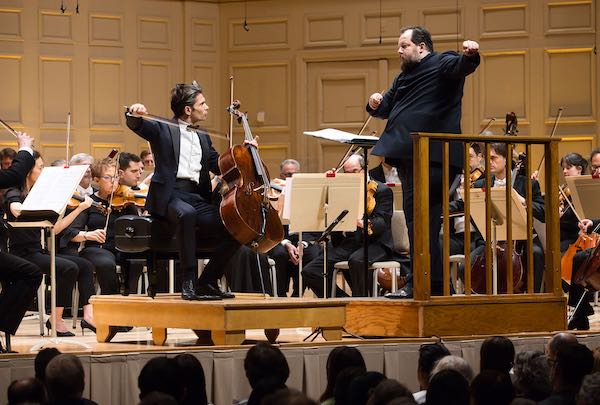Classical Concert Review: BSO’s Nelsons leads Escaich; Chamber Players Perform Ravel, Gubaidulina, and Beethoven
By Aaron Keebaugh
Andris Nelsons has a fine feel for colorful musical canvases, a talent once again displayed in performances of Thierry Escaich’s Cello Concerto and Rachmaninoff’s Symphony No. 2.

Cellist Gautier Capuçon and BSO music director Andris Nelsons in a performance of Thierry Escaich’s Cello Concerto. Photo: Hilary Scott
Thierry Escaich was so enamored of the poetry of Victor Hugo that he set out to capture its Manichean conflict between light and darkness in a new cello concerto.
What emerged was Les chants de l’aube, which Gautier Capuçon and the Boston Symphony Orchestra performed for the first time on American shores this past weekend. Dark yet emotionally varied, Friday’s performance under the direction of Andris Nelsons augurs that Escaich will become even more familiar in Boston than he already has.
As popular an organist as he is a composer in his Parisian circles, Escaich last appeared in Symphony Hall in February 2020 as a soloist in Poulenc’s Concerto for Organ, Timpani, and Strings. If memory serves, his performance deftly realized that work’s spry humor and sweeping grandeur.
Les chants de l’aube, however, pits soloist and orchestra in a bitter rivalry, at least in the first of its three movements, where thorny shapes wrestle against radiant forces for prominence. Chant-like statements frame cello phrases that echo like screams into a chasm.
But the turmoil gradually smooths out into a playful banter that settles into a bracing calm. In two cadenzas, the soloist’s lines stutter and jolt, like a traumatized victim bedeviled by a painful memory. A march follows, and that charges to a final bang. The abyss, this music suggests, screams back.
Capuçon, for whom the work was written, played with a laser-like focus that generated rousing intensity and searching pathos. Nelsons let the tumultuous accompaniment unfold in declarative style.
The conductor has a fine feel for such colorful musical canvases, a talent he once again realized in Rachmaninoff’s Symphony No. 2.
Long criticized for its sentimentality, the uncut, hour-long version has become a hidden specialty for the Latvian conductor. But instead of reading the symphony as a stereotypical journey from struggle to triumph, he focuses on the intensity of each passing moment — without sacrificing the bigger picture.
Nelsons lingered in the opening movement, reveling in its lyricism. Sure, he micromanaged here and there — the falling string figures of the second theme were drawn out in the extreme. But all the parts came together to conclude with a stellar overall effect.
The Scherzo took on an impish glee, with trios that flowered beautifully in fitting contrast. The romping finale culminated an interpretation that had, at first, felt ponderous because of its attention to detail. Nelsons displayed his greatest strengths for shape and grandeur in the Adagio, where he cultivated the music’s emotional gravity without indulging in overstatement.
The opener, Ravel’s Alborada del gracioso, delivered just as much live-wire urgency.
The orchestration of this movement from Miroirs flares with color and texture. Nelsons took listeners on a vivid tour, navigating its coiled tensions with satisfying finesse.
Ravel’s music frequently spotlights soloists and ensemble alike. That was most evident in the Boston Symphony Chamber Players’ performance of the composer’s “Introduction and Allegro” for harp, flute, clarinet, and string quartet on Sunday afternoon at Jordan Hall.
Sleek, silvery sonorities from strings, flute, and clarinet beautifully framed harpist Jessica Zhou’s golden harmonics and arpeggios. This was a performance that flowered with every turn of phrase, its quicker sections put across with an apt dynamic thrust.
Bassist Edwin Barker and pianist Randall Hodgkinson, by contrast, supplied an eerie and spacious drama with Sofia Gubaidulina’s Sonata for Double Bass and Piano.
This score from 1975 places the two instruments in a quirky dialogue that never quite finds resolution. Throughout, Barker provided a dusky presence, scratching out lines that blurred against Hodgkinson’s faint chords. Their duet gradually swelled to an uneasy standoff conveyed with aplomb.
Beethoven’s Septet, Op. 20 delivered the afternoon’s most theatrical sweep.
The rough-edged sonority the Chamber Players brought to the outer movements made the sudden shifts in texture resound with extra force. They softened their approach in the Adagio, attaining an almost romantic plushness.
The theme and variations bounded with courtly grace, the Scherzo and Minuet with a rustic vitality. This was a vision of early Beethoven that looked toward the future — relishing mystery before dancing toward the light.
Aaron Keebaugh has been a classical music critic in Boston since 2012. His work has been featured in the Musical Times, Corymbus, Boston Classical Review, Early Music America, and BBC Radio 3. A musicologist, he teaches at North Shore Community College in both Danvers and Lynn.
